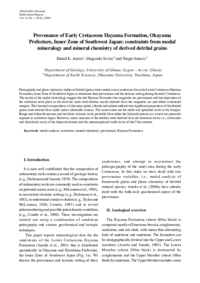

岡山大学 地球科学研究報告
Published by Okayama University Earth Science Reports Editorial Committee
岡山県に分布する白亜紀前期羽山層砕屑物質の供給源:砕屑粒の鉱物化学組成とモード組成から導かれる制約
Asiedu, Daniel K.
Published Date
2009-12-25
Abstract
Petrographic and phase chemistry studies of detrital grains were carried out on sandstones from the Lower Cretaceous Hayama Formation, Inner Zone of Southwest Japan, to determine their provenance and the tectonic setting during the early Cretaceous. The results of the modal mineralogy suggest that the Hayama Formation has magmatic arc provenance and that deposition of the sediments took place in the back-arc areas with detritus mostly derived from the magmatic arc and rifted continental margins. The chemical compositions of chromian spinel, chlorite and sphene indicate that significant proportions of the detrital grains were derived from mafic and/or ultramafic sources. The source areas are the mafic and ophiolitic rocks in the Sangun-Renge and Akiyoshi terranes and the felsic volcanic rocks probably from either the Akiyoshi terrane or a source not presently exposed in southwest Japan. However, minor amounts of the detritus were derived from the basement rocks; i.e., carbonates and siliciclastic rocks of the Akiyoshi terrane and the metamorphosed mafic rocks of the Chizu terrane.
Keywords
modal analysis
sandstone
mineral chemistry
provenance
Hayama Formation
ISSN
1340-7414
NCID
AN10506284
NAID
JaLCDOI
